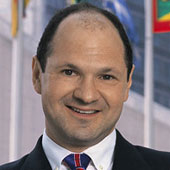Russia and America: Brothers in Arms?
Can former foes get much more closer ?
March 1, 2001
Americans and Russians have a lot in common. Sure, during the Cold War, such a comment would not have found favor on either side of the Atlantic. But after the tumultuous period of the Cold War, when Mikhail Gorbachev opened up the Soviet Union in the late 1980s, Americans and Russians once again rushed out to hug each other.
Astonishing people-to-people coalitions sprung up overnight between the societies of the erstwhile mortal enemies. Just take America’s Vietnam vets who found soul mates among Russia’s Afghan paratroopers — and Alcoholics Anonymous graduates from the United States who taught their twelve-step magic to Russian tipplers.
Yet, toward the end of the 1990s, talk of any possible “convergence” ended there. On the contrary, the two countries began to move in the opposite directions.
Russia suffered an economic, social and military collapse. Its economy shrank to just 2% of U.S. GDP. During the Soviet era, a ruble bought a U.S. dollar at the official exchange rate. Now, it takes almost 30,000 rubles to buy a dollar. And Russia’s military is being manhandled by ragtag rebels in Chechnya.
Yet, underneath all the newspaper headlines and apart from all the profound policy debate, convergence between the two countries has been proceeding apace at a societal level at least.
In the past, Russians traveling abroad used to be instantly recognizable in airports by their wrinkled polyester suits, unkempt hair and fake-leather shoes — as well as a tendency to gravitate toward the consumer electronics section at duty free shops.
Now, however, Russian elites have consciously modeled themselves after their U.S. counterparts. Even second-tier oligarchs and middling government officials have contrived to look like U.S. CEOs — complete with expensive briefcases and Swiss watches.
Russia’s newly prosperous also share America’s love for huge, gas-guzzling motor vehicles. These days, the only places where you see Hummers driven by civilians, and not by the US Army, are Beverly Hills, Miami, East Hampton — and Moscow.
The prevalence of SUVs and ubiquitous McDonald’s signs are not the only things that make Moscow look more and more like New York. Slums and beggars do, too. In fact, when Richard Nixon came to Moscow in 1973, buildings along his airport route were given a fresh coat of paint. Bums, alcoholics and other “undesirables” were evicted from the city.
And the same process took place whenever the Soviet Union staged a high-profile international event, such as the 1980 Olympics.
In the post-Soviet era, the government no longer feels the need to build such Potemkin villages. At the same time, poverty and social problems increased sharply. As a result, beggars and the homeless now prowl Moscow streets in New York-like numbers. So-called “squeegee men,” who clean the windshields of cars stopped at traffic lights were eradicated by New York Mayor Rudy Giuliani a decade ago, but still accost motorists in Moscow.
From rich to poor, Russian and U.S. societies increasingly resemble one another. After half a century of isolation during the Cold War, it took only a decade for signs of conversion to surface. There is no telling what the future holds for U.S.-Russian relations.
Read previous
Talking Turkey
February 28, 2001
